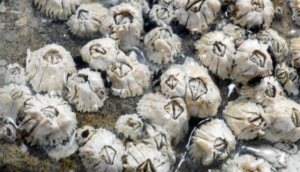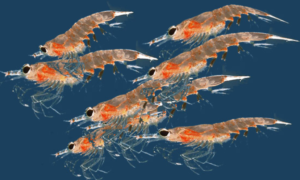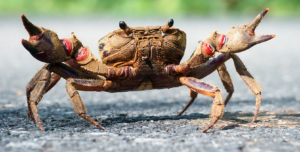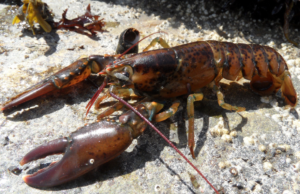 When you think crustaceans, you could probably come up with crabs and lobsters and shrimp without too much prompting. But a creature you might not consider right away is the barnacle. That’s right, those little guys you see attached to the side of ships are actually crustaceans. There are around 1220 species of barnacle knows currently (filling a tank for all of those creatures would be the dream of any water supply company), and of those, the most popular is the acorn barnacle, shown above. Barnacles are all sessile, which means that they are immobile, and attach themselves to other, larger objects with a super-sticky glue. This fast-curing cement that they produce is one of the most effective glues in the natural world, and, in fact, known to man. Having a tensile strength of 5000 pounds per square inch, it’s no wonder people are looking at a way to harvest it and use it commercially.
When you think crustaceans, you could probably come up with crabs and lobsters and shrimp without too much prompting. But a creature you might not consider right away is the barnacle. That’s right, those little guys you see attached to the side of ships are actually crustaceans. There are around 1220 species of barnacle knows currently (filling a tank for all of those creatures would be the dream of any water supply company), and of those, the most popular is the acorn barnacle, shown above. Barnacles are all sessile, which means that they are immobile, and attach themselves to other, larger objects with a super-sticky glue. This fast-curing cement that they produce is one of the most effective glues in the natural world, and, in fact, known to man. Having a tensile strength of 5000 pounds per square inch, it’s no wonder people are looking at a way to harvest it and use it commercially.
Krill
 If you’re anything like me, the first time you heard of krill was in Finding Nemo, right before Marlin and Dory get eaten by the whale, and since then you’ve heard about them here and there in nature documentaries, and they’re always getting eaten. Although it’s true that they’re basically always getting eaten, but don’t you go thinking that that means they’re not important. In fact, the reason they’re so important is the fact that they’re at pretty much the bottom of the food chain. Krill can be found in all the oceans of the world, and are a source of food for whales, fish, squid, penguins (and are in far higher numbers than even my cousin’s Aurora towing services could handle, let me tell you). In fact, if the krill in the Antarctic region were to disappear, most other species in the Antarctic would disappear. Krill make such good meals because they feed on plankton, the nutrients of which they convert into a form that can benefit their predators.
If you’re anything like me, the first time you heard of krill was in Finding Nemo, right before Marlin and Dory get eaten by the whale, and since then you’ve heard about them here and there in nature documentaries, and they’re always getting eaten. Although it’s true that they’re basically always getting eaten, but don’t you go thinking that that means they’re not important. In fact, the reason they’re so important is the fact that they’re at pretty much the bottom of the food chain. Krill can be found in all the oceans of the world, and are a source of food for whales, fish, squid, penguins (and are in far higher numbers than even my cousin’s Aurora towing services could handle, let me tell you). In fact, if the krill in the Antarctic region were to disappear, most other species in the Antarctic would disappear. Krill make such good meals because they feed on plankton, the nutrients of which they convert into a form that can benefit their predators.
Crabs
 Crabs! (and obviously we’re talking about the crustaceans here) Crabs are ten-footed creatures or decapods, if you’re fancy like Dayton party bus services, just like lobsters. Unlike lobsters, however, they have only two claws, and their abdomens are smaller than a lobster’s, and are tucked up under their shell (which is an exoskeleton, like a lobster), giving them a much more roundish kind of shape. Crabs are very versatile little fellows, and can be found not only in every ocean on the planet, but also in fresh water and on land (so basically, if they wanted to take over, they pretty much could). Do take note, however, that if such an invasion of crabs were to occur, it would not include creatures like the hermit crab or the king crab, because, though they do have the word crab in their names, they are not true crabs.
Crabs! (and obviously we’re talking about the crustaceans here) Crabs are ten-footed creatures or decapods, if you’re fancy like Dayton party bus services, just like lobsters. Unlike lobsters, however, they have only two claws, and their abdomens are smaller than a lobster’s, and are tucked up under their shell (which is an exoskeleton, like a lobster), giving them a much more roundish kind of shape. Crabs are very versatile little fellows, and can be found not only in every ocean on the planet, but also in fresh water and on land (so basically, if they wanted to take over, they pretty much could). Do take note, however, that if such an invasion of crabs were to occur, it would not include creatures like the hermit crab or the king crab, because, though they do have the word crab in their names, they are not true crabs.
Lobsters
 When I think traditional lobster, I think Homer Simpson’s ill-fated friend Pinchy; you know the type, just the simple red, big-clawed, beady-eyed guys. The fellows you might see in that too-small tank at the grocery store and are the favourite of many restaurants and catering companies.
When I think traditional lobster, I think Homer Simpson’s ill-fated friend Pinchy; you know the type, just the simple red, big-clawed, beady-eyed guys. The fellows you might see in that too-small tank at the grocery store and are the favourite of many restaurants and catering companies.
My good friend who owns an airport shuttle Fayetteville NC is a huge fan of sea food. He knows all about lobsters…they are his favourite! He told me all about the different families of lobster (which I frankly should have guessed), and that there are some creatures with “lobster” in their names, but that aren’t actually lobsters at all (because that would be too easy). The most common family of lobster – what you probably picture when you think about a lobster – is likely the family Nephropidae (pictured on the right).